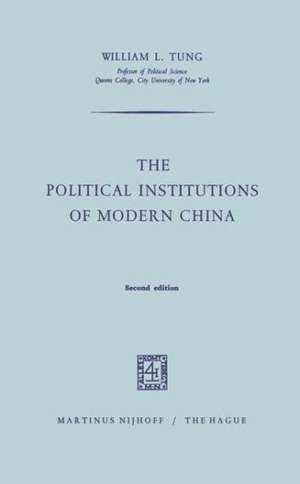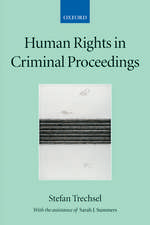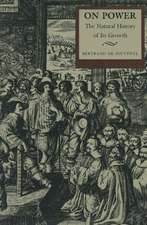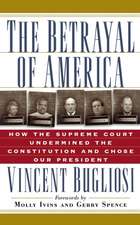The Political Institutions of Modern China
Autor W.L. Tungen Limba Engleză Hardback – 31 iul 1968
| Toate formatele și edițiile | Preț | Express |
|---|---|---|
| Paperback (1) | 950.66 lei 6-8 săpt. | |
| SPRINGER NETHERLANDS – 25 noi 2011 | 950.66 lei 6-8 săpt. | |
| Hardback (1) | 956.81 lei 6-8 săpt. | |
| SPRINGER NETHERLANDS – 31 iul 1968 | 956.81 lei 6-8 săpt. |
Preț: 956.81 lei
Preț vechi: 1166.84 lei
-18% Nou
Puncte Express: 1435
Preț estimativ în valută:
183.11€ • 190.46$ • 151.17£
183.11€ • 190.46$ • 151.17£
Carte tipărită la comandă
Livrare economică 15-29 aprilie
Preluare comenzi: 021 569.72.76
Specificații
ISBN-13: 9789024705528
ISBN-10: 9024705525
Pagini: 428
Ilustrații: XIV, 408 p.
Dimensiuni: 155 x 235 x 28 mm
Greutate: 0.77 kg
Ediția:1968
Editura: SPRINGER NETHERLANDS
Colecția Springer
Locul publicării:Dordrecht, Netherlands
ISBN-10: 9024705525
Pagini: 428
Ilustrații: XIV, 408 p.
Dimensiuni: 155 x 235 x 28 mm
Greutate: 0.77 kg
Ediția:1968
Editura: SPRINGER NETHERLANDS
Colecția Springer
Locul publicării:Dordrecht, Netherlands
Public țintă
ResearchCuprins
I. From Autocracy to Democracy: Political Institutions at the End of the Ch’ing Dynasty.- 1. Transformation from Absolute to Constitutional Monarchy.- 2. Causes of the Constitutional Movement.- 3. Preparation for Constitutionalism.- 4. The Principles of Constitution, September 22, 1908.- 5. The National Legislative Council (Tse-cheng Yuan).- 6. The Provincial Assembly (Tse-I Chu).- 7. The Beginning of Local Self-Government.- 8. The Revolution and the Nineteen Articles of November 3, 1911.- II. Democracy in Experiment: Political Institutions During the Early Republican Period.- 1. Preparations for a Provisional Government.- 2. Analysis of the Organic Law of the Provisional Government.- 3. Inauguration of the Provisional Government at Nanking.- 4. The Provisional Constitution of the Republic of China, March 11, 1912.- 5. The Change of the Provisional Presidency and the Seat of Government.- 6. The Establishment of Parliament.- 7. The Drafting of the Constitution and the Election of President.- 8. The Judicial System of the New Republic.- 9. The Local Government System.- III. Monarchism vs. Republicanism: Political institutions Under the Dictatorship of Yüan Shih-K’ai.- 1. Yüan Shih-k’ai vs. Constitutional Democracy.- 2. Yüan Shih-k’ai and the Constitutional Compact of 1914.- 3. The Reorganized National Government Under Yüan Shih-k’ai.- 4. The Local Government System Under Yüan Shih-k’ai.- 5. The Rise and Fall of Yüan’s Monarchial Movement.- IV. Split Between the North and the South: Political Institutions During the Period of Internal Dissensions.- 1. Developments under the Regime in Peking.- 2. The New Parliament and the New Constitutional Draft.- 3. Parliament’s Second Restoration and its Adoption of the 1923 Constitution.- 4. TheConstitution-Protecting Government in the Southwest.- 5. The Peking Government Under Provisional Chief Executive Tuan.- 6. The Local Government System.- V. The Nationalist Party in Power: Unification of China Under Kuomintang Programs.- 1. The Reorganization of the Nationalist Party in 1924.- 2. Basic Principles and Programs of the Nationalist Party.- 3. The Northern Expedition and the Unification of China.- 4. The Beginning of Political Tutelage.- VI. The Five-Power Constitution at Work: Political Institutions During the Period of Political Tutelage.- 1. The National Government Before 1928.- 2. The National Government Since 1928.- 3. The National People’s Convention and the Promulgation of the Provisional Constitution of the Republic of China for the Period of Political Tutelage.- 4. Nationalist Efforts to Carry out Party Principles and Programs.- 5. The Preparation for Constitutional Rule in China.- 6. The Local Government System During the Period of Political Tutelage.- VII. Communism Versus Nationalism: The Chinese Communist Party and Soviet Regimes (1921–1945).- 1. The Formation of Communist Organizations in China.- 2. The First United Front of the Nationalists and Communists.- 3. Armed Uprisings and the Change of Leadership.- 4. The Establishment of Soviet Regimes in China.- 5. The Second United Front and Expansion of the Communist Regimes.- VIII. China at War: Political Institutions During the Period of the Sino-Japanese War.- 1. The Hostilities Between China and Japan.- 2. The Formal Establishment of Chiang Kai-shek’s Leadership.- 3. Wartime Party Alignments.- 4. The Supreme National Defense Council — The Highest Organ of Wartime China.- 5. The Triple-linked Administrative System.- 6. The Wartime National Government.- 7. The People’s PoliticalCouncil.- 8. The Wartime Local Government.- 9. The Local Representative Bodies.- IX. From the Mainland to Taiwan (Formosa): Political Institutions during the Postwar Period.- 1. Peace Negotiations Through the Political Consultative Conference.- 2. The Convocation of the National Assembly and the Constitution of 1946.- 3. The Central and Local Governments Under the Constitution of 1946.- 4. The First Session of the First National Assembly.- 5. The Nationalist Debacle and Retreat to Taiwan.- 6. The National Government in Taiwan.- 7. The Local Government System in Taiwan.- 8. Taiwan Today.- X. The Communist Party in Power: Mao’s Political Thought and the Party Organization.- 1. On the Road to Victory.- 2. The Political Thought and Strategy of Mao Tse-tung.- 3. The Constitution of the Chinese Communist Party and its Guiding Principles.- 4. The Organization and Functions of the Communist Party.- 5. The Communist Youth League.- 6. The Communist Relationship with Minor Political Parties and Mass Organizations.- XI. Fundamental Laws of the People’s Republic: From the Common Program to the Constitution of 1954.- 1. The Chinese People’s Political Consultative Conference (CPPCC).- 2. The Common Program of 1949 in the Nature of a Provisional Constitution.- 3. The Central Government System, 1949–1954.- 4. The Local Government System, 1949–1954.- 5. The Adoption of the Constitution by the National People’s Congress.- 6. General Principles of the Constitution of 1954.- XII. The Government of “Democratic Centralism”: Political Institutions under the Constitution of 1954.- 1. The Present System of Government.- 2. The National People’s Congress.- 3. The Head of the State.- 4. The State Council.- 5. The People’s Courts and Procuratorates.- 6. Local People’sCongresses and Councils.- 7. Self-Government Organs of National Autonomous Areas.- 8. The Communist Government in Action.- Appendices.














